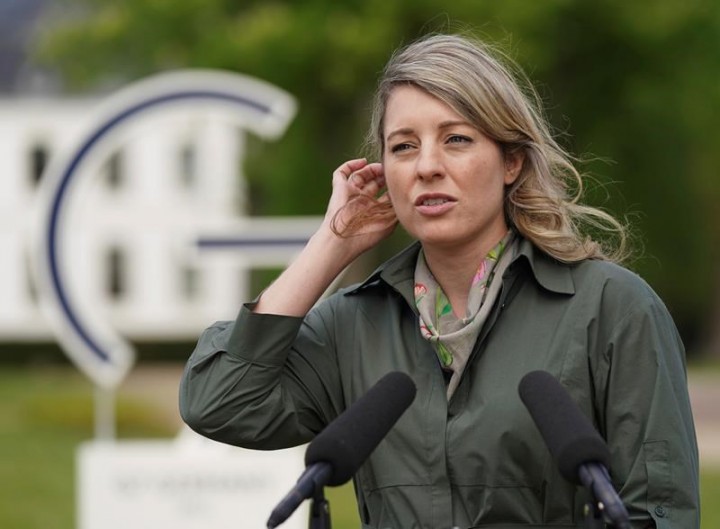OTTAWA — Foreign Affairs Minister Mélanie Joly kicked off two days of meetings Wednesday at the United Nations to help mobilize a global response to the food security crisis resulting from Russia’s invasion of Ukraine.
Joly met with UN Secretary-General Antonio Guterres and Rosemary DiCarlo, the undersecretary-general for political and peacebuilding affairs, before taking part in a ministerial “call to action” on the growing problem of food insecurity around the world.
The meeting, convened by U.S. Secretary of State Antony Blinken, was dominated by the escalating humanitarian crisis triggered by Russian President Vladimir Putin’s invasion, which is about to enter its 13th week.
Prior to the start of the war in late February, the number of people around the world facing a crippling food crisis reached more than 161 million people in 2021, up from 108 million in 2016, Blinken said in his introductory remarks.
The World Bank has estimated the invasion could well drive an additional 40 million more people around the planet into extreme poverty, he added.
“Every driver of the crisis that we’ll discuss today has been made worse by President Putin’s war of choice,” Blinken said. “It’s a crisis that demands a global response.”
Russia has blockaded Ukraine’s ports, stopping exports of wheat and sunflower oil to countries that rely on them in the Middle East, Asia and Africa.
“Canada’s approach will be bold: from providing funding at the multilateral level to logistical supply chain support to food inspectors and cargo shipments, we will get involved,” Joly told her fellow delegates.
“We will free Ukrainian grains, and countries will receive their shipments. To the secretary-general, of course, we will support his efforts to find peaceful and lasting solutions to get those grains out.”
Canada will be sending cargo ships to ports in Romania and other European countries neighbouring Ukraine to help it export its wheat — what Joly described in her speech Wednesday as “freedom wheat.”
The UN World Food Program has warned that the conflict has not only driven up the price of grain, making it more expensive to feed the hungry, but could push nations that rely on Ukrainian wheat toward starvation.
Ukraine is one of the world’s biggest exporters of wheat, with some countries, including Lebanon and Bangladesh, relying on it as a staple food.
“Let me be very clear and to the point: failure to open the ports will be a declaration of war on global food security, resulting in famine, destabilization of nations, as well as mass migration by necessity,” said David Beasley, the former South Carolina governor who now serves as the program’s executive director.
“This is not just about Ukraine. This is about the poorest of the poor around the world who are on the brink of starvation as we speak. So I ask President Putin, if you have any heart at all, to please open these ports.”
Julie Marshall, Canadian spokeswoman for the World Food Program, said Ukraine produces enough to feed about 400 million people around the world. But millions of tons of wheat, much of it bound for developing nations, is sitting in silos and stranded on ships because of the conflict.
Ukraine’s ambassador to Canada, Yulia Kovaliv, told a committee of MPs that not only is Russia blockading Ukraine’s ports, it is stealing its grain stores and attempting to ship them to Russian-held Crimea.
Agriculture Minister Marie-Claude Bibeau has warned that the Russians are also targeting farm machinery and equipment needed to gather and distribute Ukraine’s harvest.
Canada is one of the world’s biggest wheat exporters and has said it will do what it can to help with the shortfall. But Bibeau has said that Canada and the U.S. had a weak harvest last year because of a drought so stocks of grain are lower than usual.
“Our farmers are in the field; planting season has started,” Joly said, describing herself as the granddaughter of a wheat grower and miller. “Let’s hope Mother Nature is on our side.”
She acknowledged that Canada — one of the world’s largest producers of potash, a key ingredient in fertilizer that is also in short supply — has not imposed sanctions on Russian and Belarusian exports the same way that other G7 countries have done.
The government is working on ways to get its own potash to ports around the world, Joly said, and will “chart a path for a long-lasting solution” to the question of sanctions.
On Thursday, Joly will take part in an open debate at the UN Security Council, which the U.S. currently heads, on the links between conflict and food security.
During that debate, Joly will “highlight the need to find long-term solutions to break the cycle of poverty, hunger, and conflict, and to increase resilience, especially in the least-developed countries,” Global Affairs Canada said in a release.
This report by The Canadian Press was first published May 18, 2022.
Marie Woolf, The Canadian Press
